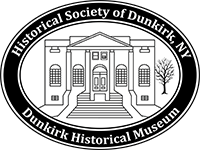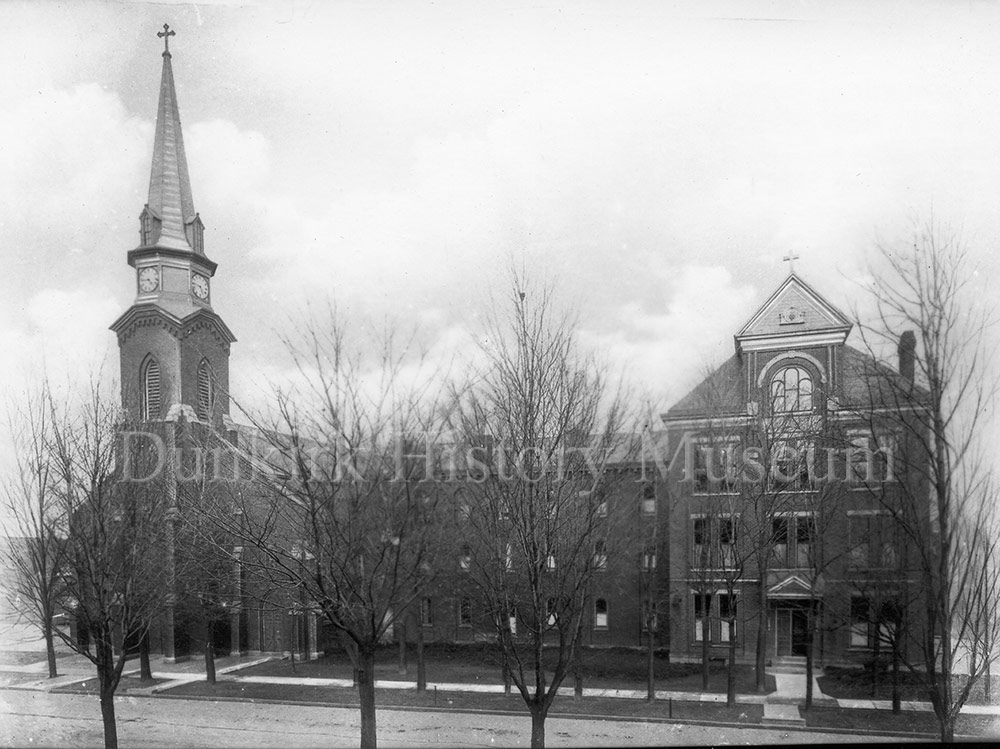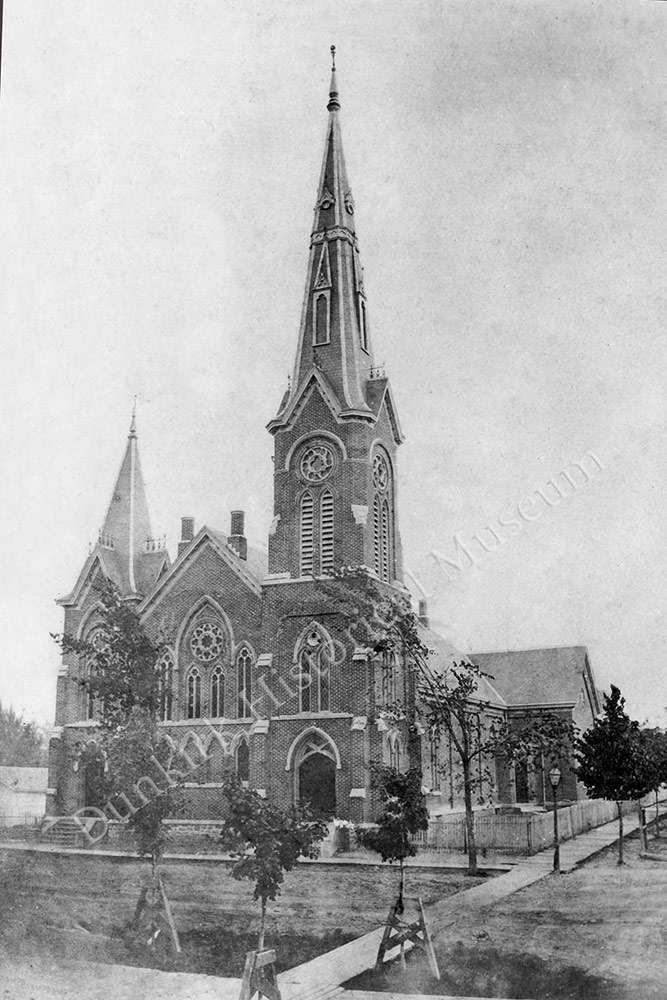In the earliest days of the settlement that would come to be called Dunkirk, various ministers visited the community for the religious needs of the population. This included Joy Handy, a Baptist minster, and John Spencer, a Congregationalist who also ministered to the Presbyterians. These men along with other “itinerant minsters” traveled throughout the northern Chautauqua County holding services in homes, barns, and the open air. In 1830 the Rev. Joy Handy finally organized a church of twenty Baptist members, the group meeting in the same small brick building on East Third built by Walter Smith for the purpose of a school. In 1835 a resident pastor was finally engaged and in 1853 the group would build its own church on the southeast corner of East Fourth and Buffalo Streets (Washington), the pastor then being the Rev. J. H. Walden.
In 1830 a Presbyterian congregation was also organized with ten charter members, including Sarah Williams, wife of Ezra Williams, the community’s first physician. Timothy Stillman, a graduate of Yale University and the Auburn Theological Seminary, served as their pastor. The congregation shared the same brick school building on Third Street. In 1833 they began construction of a building on the corner of East Third and Center Streets, digging the basement and enclosing it for their services. Three years later they completed the wooden structure. The Presbyterians came under the leadership of Rev. Myron Adams, father of novelist Samuel Hopkins Adams, and they built a brick church on West Fourth opposite the Episcopal church. A religious controversy split the church in 1880, when the Rev. Myron Adams, advocated the new liberal theological ideas in the church, rejecting the Calvinistic doctrine of predestination and eternal punishment. When he resigned to take a new assignment in Rochester, he sought a minister of equal liberal thinking, deciding on his younger brother Edward P. Adams, who was invited to preach for a month and resulted in his being asked to become permanent pastor. When he too rejected the doctrine of eternal punishment, the sermon in which he did so was published in local and Buffalo papers, causing him to be summoned to answer charges to the Buffalo Presbytery. He was subsequently suspended from his ministry and then permanently removed. Ninety members of the church who were supporters of Rev. Adams formed the “City Hall Congregation” as they held services in city hall until the death of Rev. Adams. The Unitarian church that formed afterwards named their church the Adams Memorial Church in his memory. The First Presbyterian Church still functions on East Fourth Street. The Adams Memorial Church on Central Avenue closed, was turned into an art gallery, and then abandoned.
Between 1850 and 1860 the population of Dunkirk increased from 2900 to 4000, much of the increase due to the influx of Irish and German immigrants, many of them arriving to build the railroad and many of them being Roman Catholic. In response to this influx the Bishop of Buffalo, Rev. John Timon, visited Dunkirk often to celebrate mass in various homes. In 1850 Father Lennon was sent to organize a parish. He purchased two old houses on Robin and Second Streets and converted one into a chapel dedicated to “The Seven Dolors of Mary.” Rev. Peter Colgan was soon appointed minister, remaining for nine years, and building the first unit of the present St. Mary’s Church (now St. Elizabeth Ann Seton), which was occupied in 1854 and attended by 440 Irish and German immigrants. St. Elizabeth Ann Seton Parish still functions on Washington Avenue.
Episcopalians organized their St. John the Baptist parish in 1850, services being held in the Loder House on Center (Central Ave) until they built a church on Center/Central in 1852. They subsequently built a brick church on West Fourth Street in 1868. It still stands.
The Methodists built a small frame church on East Fourth Street in 1853, the Reb. H. C. Wright serving as pastor, the wooden church replaced by a brick one in 1879 on the corner of Sixth and Washington Avenue. The church remains in existence.
The Lutherans organized under the Rev. Peter Straus in 1856, the German speaking congregation building a frame church on the corner of East Fourth and Leopard Street in 1859.
The German Roman Catholics organized their own parish in 1857, dedicating it to St. George (the school eventually being called St. George’s) with Father D. Geimer leading the congregation to build a small frame church in 1858. In 1874 they built a stone church on Main Street and changed its name to the Church of the Sacred Heart of Jesus.
In 1875 eighty five Polish Catholic families built St. Hyacinth’s Roman Catholic Church on Lake Shore Drive East. Poles were found in Dunkirk as early as 1848, while most arrived from the Galicia area after the massacre of Polish gentry by the Russians. They comprised the majority of workers at the Brooks Locomotive Works, while many others were farmers. A new church was built across the street from the old one as its replacement in 1960. The parish combined with that of St. Hedwig’s in 2008 and operates as Blessed Mary Angela Parish.
Immigrants of the Jewish faith began arriving in the 1860’s but did not establish a formal worship place until 1914, when 16 members of their community formed the Hebrew Community of Dunkirk. They used the Dunkirk Cycle Club on Washington Avenue in which to hold services, and then built a new temple, paying its mortgage off in 1941. Of some interest is the fact a member of their faith became mayor in 1907.
In 1902 two hundred Polish families residing in the northeast area of Dunkirk (Fourth Ward) formed St. Hedwig’s Roman Catholic Parish, first erecting a wooden church at the corner of Roberts Road and Doughty Street. In 1903 a new brick church and school were built, which was destroyed by fire in 1905. It was rebuilt in 1907, and then in turn that building was replaced in 1972 by a more modern structure.
The first permanent Italian immigrant arrived in 1888 followed by 20 more families in the next few years, the families at first attending St. Mary’s Church. In 1908 Holy Trinity Parish was formed to minister to the needs of the Italians and they at first worshiped in in a store owned by Concenzio Novelli at 84 East Third St. They built Holy Trinity Church on the corner of Ruggles and Wright Streets in 1909. That church closed and was torn down in 1972 with its replacement being dedicated in the same year in its new location on Central Avenue, where it continues to this day.





